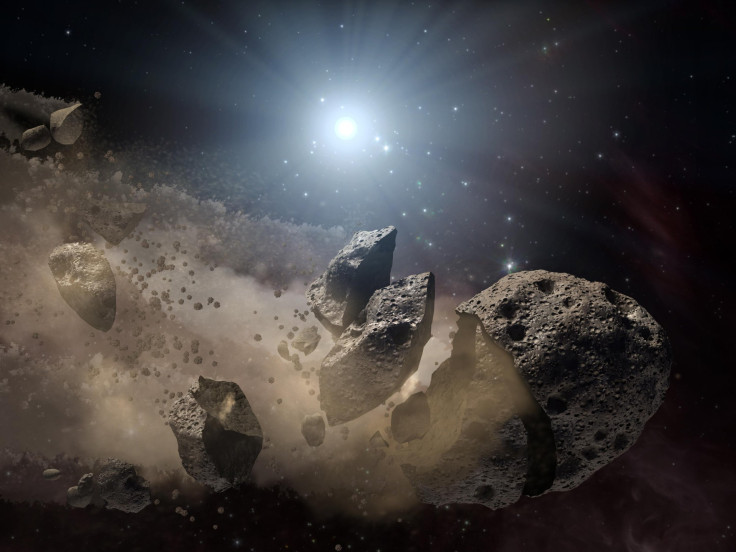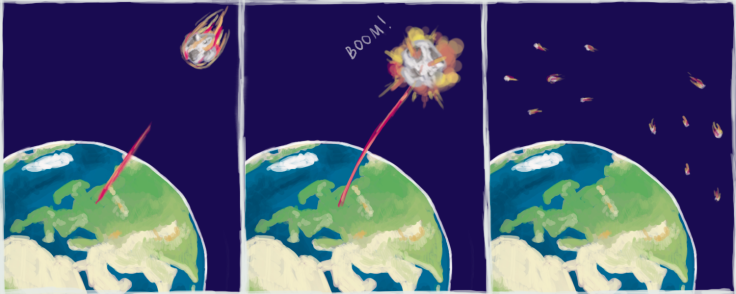Shooting Lasers At Asteroid Models To Simulate Nuclear Defense Against Potential Collisions

An asteroid roughly the size of a sports stadium passed Earth by in the first week of March, traveling at a speed of about 4 miles a second at a distance almost four time that is between our planet and the moon. While that may seem pretty far away, NASA classifies any asteroid larger than 150 meters (about 490 feet) across and within 7.5 million kilometers (4.6 million miles) from Earth to be potentially hazardous.
There are two different approaches researchers have taken to deal with the scenario of an asteroid which is headed on a crash-course with Earth. One is to hit the asteroid with the aim of changing its trajectory, so it avoids our home planet completely. The other is to hit it much harder, say with a nuclear device, and blow it up into pieces that would either take a different course or would burn up in Earth’s atmosphere, and would therefore cause no harm.
Russian scientists simulated the second scenario in a laboratory, using lasers and models of asteroids they made. Researchers from Rosatom, Russia’s State Atomic Energy Corporation, and physicists from the Moscow Institute of Physics and Technology (MIPT) came together to evaluate the criteria for destroying asteroids, “such as the explosion energy needed to eliminate a dangerous object on a collision course with Earth.”
The researchers designed their model asteroids based on data from a meteorite that survived the Chelyabinsk explosion in February 2013 and landed inside the nearby Lake Chebarkul. The fragment was recovered from the lake’s bottom and analyzed, and researchers created model asteroids of various shapes using a combination of various physical processes, such as heating, compression and sedimentation, to mimic natural formation.
It was found that to destroy a 200-meter asteroid, as much energy as produced by 3 megatons of TNT would be needed, which could be achieved using most nuclear warheads in existence today. By firing lasers at pre-built cavities in the model asteroids, researchers also surmised that less energy was needed to destroy asteroids if the bomb was buried within their surfaces. A succession of small explosions was seen to provide no advantage over a single large explosion.
“By accumulating coefficients and dependencies for asteroids of different types, we enable rapid modeling of the explosion so that the destruction criteria can be calculated promptly. At the moment, there are no asteroid threats, so our team has the time to perfect this technique for use later in preventing a planetary disaster,” Vladimir Yufa, an associate professor at MIPT who coauthored a research paper on the subject, said in a statement Tuesday.

“We’re also looking into the possibility of deflecting an asteroid without destroying it and hope for international engagement,” he added.
The conclusions of the study hold validity only for similar-sized asteroids as the one responsible for the Chelyabinsk explosion, and they would also have to enter Earth’s atmosphere at a similar angle, with their fragments following similar trajectories, the researchers clarified. They plan to experiment on asteroid models with different compositions.
An English version of the research paper will be published in the upcoming issue of the Journal of Experimental and Theoretical Physics.
Asteroids can be as small as a few meters across, but can also be several hundred kilometers in size, and can travel up to five times faster than the one that flew by Earth on March 7. The NASA classification is designed to err on the side of caution, because if an asteroid were to hit Earth, the devastation caused would be immense, like the Cretaceous-Paleogene mass extinction event 66 million years ago. At the time, an object from space, thought to be about 10 to 15 kilometers across, struck our planet and caused the sudden extinction of 75 percent of all plant and animal species on land and in water.
NASA is also working on a spacecraft — the Hypervelocity Asteroid Mitigation Mission for Emergency Response (HAMMER) — which would be designed for the purpose of tackling an Earth-bound asteroid. Its bulk would either send a small asteroid on a different trajectory, or in the case of a bigger one, it would be fitted with a nuclear weapon that would do its job (hopefully, for everyone alive at the time) with a bang.
© Copyright IBTimes 2025. All rights reserved.





















